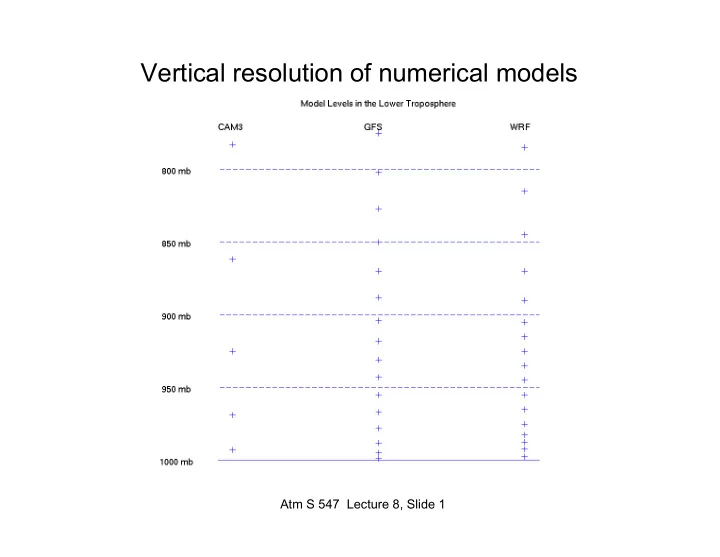

Vertical resolution of numerical models Atm S 547 Lecture 8, Slide 1
M-O and Galperin stability factors Atm S 547 Lecture 8, Slide 2
Profile vs. forcing-driven turbulence parameterization Mellor-Yamada turbulence closure schemes are profile-driven : Nonturbulent processes destabilize u,v, θ v profiles. è The unstable profiles develop turbulence. • Such schemes (except 1st order closure) can be numerically delicate: Small profile changes (e.g. from slightly stable to unstable strat) can greatly change K H,M (z), turbulent fluxes, hence turbulent tendencies. This can lead to numerical instability if the model timestep Δ t is large. TKE schemes are popular in regional models ( Δ t ~ 1-5 min). • • Most models use first-order closure for free-trop turbulent layers. K-profile approach is forcing-driven : K H,M (z) are directly based on surface fluxes or heating rates. More numerically stable for long Δ t • Hence K-profile schemes popular in global models ( Δ t ~ 20-60 min). • • However, K-profile schemes only consider some forcings (e. g. surface fluxes) and not others (differential advection, internal radiative or latent heating), so can be physically incomplete. Atm S 547 Lecture 8, Slide 3
K-profile method • Parameterize turbulent mixing in terms of surface fluxes (and possibly other forcings) using a specified profile scaled to a diagnosed boundary layer height h. • Example: Brost and Wyngaard (1978) - for stable BLs ku * z K m ( z ) = (1 − Z ) 3/2 ( Z = z/h ) φ m ( z L ) M-O form • h empirically diagnosed using threshold bulk Ri, e. g. ( ) h b ( h ) − b sfc 2 = Ri crit = 0.25 2 + v ( h ) − v sfc 2 + 100 u * ( ) ( ) u ( h ) − u sfc where ‘ sfc ’ = 20 m Vogelezang&Holtslag 1996 Atm S 547 Lecture 8, Slide 4
A challenge to downgradient diffusion: Countergradient heat transport • In dry convective boundary layer, deep eddies transport heat • This breaks correlation between local gradient and heat flux • LES shows slight q min at z=0.4h, but w ’q’ >0 at z<0.8h • ‘ Countergradient ’ heat flux for 0.4 < z/h < 0.8 … first recognized in 1960s by Telford, Deardorff, etc. Cuijpers and Holtslag 1998 Atm S 547 Lecture 8, Slide 5
CLUBB shines for marine Cu under Sc BLs GCSS ATEX intercomparison case, Bogenschutz et al. 2012 GMD, Fig. 7a Atm S 547 Lecture 8, Slide 6
Nonlocal schemes This has spawned a class of nonlocal schemes for convective BLs (Holtslag-Boville in CAM3, MRF/ Yonsei in WRF) which parameterize: ∂ ⎛ ⎞ a ′ ′ = − − γ w a K ( ) z ⎜ ⎟ a a ∂ ⎝ z ⎠ Atm S 547 Lecture 8, Slide 7
Derivation of nonlocal schemes ∂ w ∂ θ ∂ z − ∂ ′ w ′ ′ θ θ d ′ w + g θ − 1 p Heat flux budget: w ′ ′ θ = − ′ ′ θ ′ ′ ′ w ∂ t ∂ z θ 0 ρ 0 dz B S T M P Neglect storage S Empirically: 2 θ * T ≈ B + 2 w * h w ′ ′ θ P = − aB − τ For convection, a=0.5, so θ = − τ ∂ θ 2 θ * ∂ z + τ w * w ′ ′ ′ ′ w w 2 h K H ( z ) Take � = 0.5 h / w * to get zero �� gradient Holtslag and Moeng (1991) at 0.4 h. Atm S 547 Lecture 8, Slide 8
Nonlocal parameterization, continued ⎛ ⎞ 2 θ * θ = − K H ( z ) ∂ θ γ θ = 2 w * w ′ ′ ∂ z − γ θ where This has the form ⎜ ⎟ ′ ′ ⎝ ⎠ w w h Although the derivation suggests � � is a strong function of z, the parameterization treats it as a constant evaluated at z = 0.4h to obtain the correct heat flux there with d � /dz = 0: ′ w (0.4 h ) = 0.4 w * ′ ⇒ γ θ = 5 θ * h . 2 w The eddy diffusivity can be parameterized from vert. vel. var.: w ( z ) = 2.8 w * 2 Z (1 − Z ) 2 , Z = z h ⇒ K H ( z ) = 0.7 w * z (1 − Z ) 2 ′ ′ w With cleverly chosen velocity scales, this can be seamlessly combined with a K-profile for stable BLs to give a generally applicable parameterization (Holtslag and Boville 1993). Atm S 547 Lecture 8, Slide 9
Comparison of TKE and nonlocal K-profile scheme UW TKE scheme (Bretherton&Park 2009) vs. Holtslag-Boville. GABLS1 (Beare et al. 2004) • Linear initial θ profile • u g = 10 m/s • sfc cooled at 0.25K/hr • 8-9 hr avg profiles • UW and HB both do well • Default CAM3 has too much free-trop diffusion, causing BL overdeepening Bretherton and Park 2009 Atm S 547 Lecture 8, Slide 10
CBL comparison Bretherton and Park 2009 • Sfc heating of 300 W m -2 • No moisture or mean wind • UW TKE scheme with entrainment closure and HB scheme give similar results at both high and low res. • Overall, can get comparably good results from TKE and profile- based schemes on these archetypical cases. Atm S 547 Lecture 8, Slide 11
Recommend
More recommend